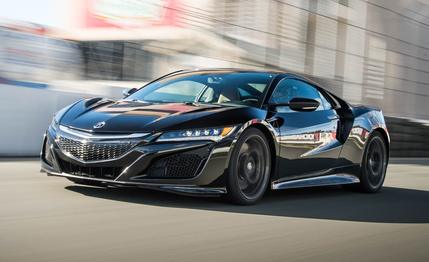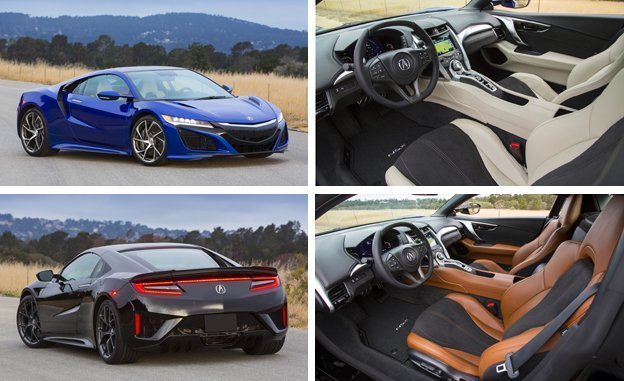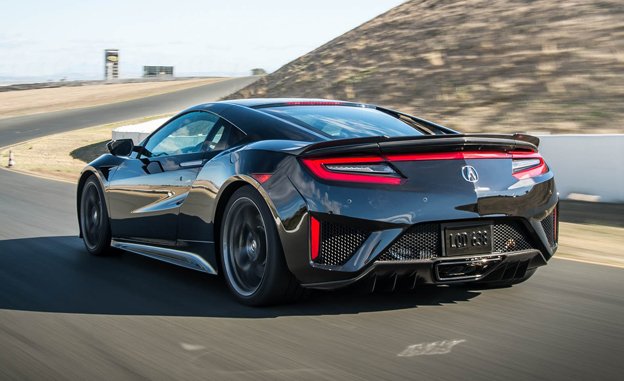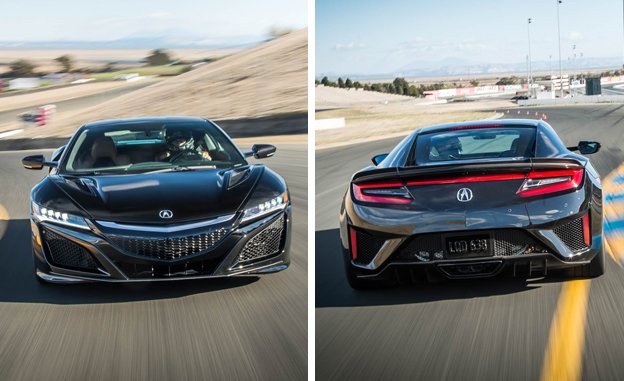
 First Drive Review
First Drive Review
Should Acura even have this car? Ailing Acura strikes us as a brand in need of reinvention from the bottom up, starting with a new Integra, the car that the people have crowned as the real keeper of Acura’s flame. Instead, Honda’s luxury brand is starting its long journey back to relevance from the top, with a hybrid supercar that will sell for more than $150,000. It’ll be a tall poppy in a showroom where the next-priciest vehicle starts at $51,870, but it’s too late to dig up old arguments about priorities. We’ve finally moved past the drawings and concepts, beyond the prototypes, and on to what the aviation industry calls the flight article. This is it, the real deal, a drivable Acura NSX with a key that has been placed in our hands. So we’ll put aside the academic critique and just go pound pavement.
What we’re about to drive is a distillation of Honda’s inner feelings at this moment. After some dark years of uncertainty, the company is ruminating on past glories, on Marlboro McLarens with Ayrton and Alain, racing bikes with oval pistons, and absurdly exquisite lawn equipment. Honda wants to be spoken of with awe again, to show the world that it’s back as a technology and performance powerhouse ready to both amaze the world and till its flowerbeds.
An aborted prototype with the transverse V-6 out of an Odyssey minivan died in mid-2012 because it couldn’t deliver amazement, and a crash program to reinvent the NSX ensued. The 2017 NSX, developed mainly in Ohio by a small group that has come to think of itself as a family, is a four-wheel-drive hybrid-electric knee to the pants of the world’s fanciest exotics. Its creators sincerely hope you like it, as do their loved ones, whom they haven’t seen in two years.


This is a prime example of filter-down technology. The layout of the three electric motors onboard—two on the front axle and a third between the twin-turbo V-6 and the nine-speed dual-clutch automatic gearbox—echoes that of the late, great $850,000 Porsche 918 Spyder, promising many of the benefits for a fraction of the price. Those benefits include rapid torque vectoring, continuous thrust assist to smooth over turbo lag and torque changes during upshifts, a modicum of fuel efficiency, and, if desired, silent operation for brief periods. Someday, this stuff will be in a Civic, but for now at least, the price tag has slid under $200,000.
Acura’s sculptors passed on the virile flair typical of the Italians, as well as the utopian futurism of the BMW i8, preferring instead a somewhat conventional, menacing angularity. It’s not an angry-looking car, but it appears determined. With its wide stance and long wheelbase, the snub-nosed body has unmistakable mid-engine proportions, and it invites a stroll around to investigate its many nooks and crannies. The flaring nostrils up front hide the radiators and the A/C condenser, while the side ducts gulp air for the intercoolers and engine intakes. The original 1991 NSX had flaplike door handles, and this one uses flush grab-sticks that angle out when needed, as on an Aston Martin.
The hood opens to a “hot box” of aluminum chassis members and equipment, the single, four-cubic-foot trunk residing behind the engine. Squat down in back and you’ll notice a cluster of what looks like Honda Fit exhaust pipes. Unusually small for a car expected to hit 60 mph in less than three seconds, the four pipes are your first hint that the NSX is not like other sports cars.
The 3.5-liter dry-sump V-6 has racing heredity in its odd, 75-degree V angle, and it fires up with an automatic rev zing now typical of high-strung machines. But it’s not a howling yap meant to turn heads in three counties, just a muffled throat-clearing heard mainly through the sound tubes plumbed from the intake plenum into the cabin. The Japanese culture emphasizes politeness. The demure NSX faithfully reflects that ethos.
To wit: The four drive modes start with “Quiet,” which allows you to sneak away in silence up to 40 mph if you’re easy on the gas pedal. Silence “can be really, really cool in a supercar,” says the NSX’s ebullient chief engineer, Ted Klaus, who behaved at the launch as if several anvils had lately been lifted from his back. “We definitely have a different opinion than Ferrari.” Definitely.
Sport is the mild-mannered default mode (you can change which mode is default, however), with steering that is a little overboosted. Acura wants the NSX to be everyday usable, a commendable goal but one that shouldn’t mean steering so light that the car changes direction over every freeway bump and dip. You can’t set steering heft or shift speed individually, so you get what the engineers give you in each mode. Sport mode quickly speeds the many-ratio transmission to its top gear for fuel economy, which is expected to peak in the mid-20s and average around 22 mpg once the EPA numbers are established.


The base tire is a Continental ContiSportContact 5 P, sized 245/35ZR-19 in front and 305/30ZR-20 in back. It’s the commuter tire, with only middling dry-road grip but the promise of wet-weather traction and some decent longevity. If you are nailing it on the open road, you’ll find the limit a tad too quickly as the front end fights for grip. Fit the optional Michelin Pilot Sport Cup 2s, almost the same meats as on the Porsche 911 GT3, and the grip becomes that of cured epoxy. But you’ll be lucky to get 15,000 miles out of a set.
Things get interesting when you turn the large console dial to Sport Plus. The electronic tachometer rotates so that redline moves to the 2 o’clock position—peak engine horsepower is at 7500 rpm—and the steering weight finally becomes appropriate to a car with 573 combined horsepower. You can lap a track in Sport Plus and get a taste of the NSX’s capabilities, but only a taste on the Continentals, which amplify the understeer tuned in for safety. In Sport Plus, the stability-control system still hovers, straightening this and nudging that and cleaning up your imperfect lines.
Hold the dial several seconds for Track mode and you finally see the vision, the car that Honda dreamed of. On the Michelins, it is ferocious, leaping at corners with steering so tightly wound that you vector the car by palm impulse. The brake pedal is just a rheostat to command (by wire) the electrohydraulic brakes, but it’s given a more organic feel by a hydraulic pressure simulator. The net effect is a firm, highly effective pedal, one that is very sensitive to minute changes in pressure. Iron discs will be standard, while the cars we drove had the optional carbon-ceramic rotors.
On the run, the NSX’s computers take data from its many sensors and work the hardware like a coxswain on a rowing team. The front motors alternately thrust through their planetary gearsets or drag in regenerative mode, while the rear tires also push or brake as needed to yaw the car in accordance with the driver’s whims. Exiting a corner, you want to get on it early to put the front’s side-by-side motors into full tractor mode to help pull the heavy NSX out with startling haste. The upshifts are heard but barely felt, the acceleration curve hardly slackening as the front motors power the car through the gearchanges and the rear motor impels the V-6 as the boost builds back to its 15.2-psi peak.


It’s a seamless operation and a vision of a future when all cars will be bionic. It’s also much too muted. The precision thrum of the V-6 piped into the cabin lacks a guttural snarl, and it’s even more disappointing for bystanders. An NSX passing by at full throttle is a whoosh of mostly tire hiss and displaced air, the engine a distant voice in the wilderness. We don’t mind that the steering wheel, comparable in feel and feedback to a Porsche 911’s, doesn’t jump in your hands, but the NSX needs more drama.
Another issue: Rather than offer a series of escalating modes that increase the driver’s freedom, as, say, on the Corvette Z06, the NSX staircase is designed for outcomes—or to make the car go ever faster. In Track mode, you can’t slide around because sliding is slower. The car intervenes with corrections that make it straighten up and fly right. Faster lap times, yes, but also not as fun. You can shut off the stability control entirely, but then you risk a wall encounter. Besides desperately needing a door bin to hold your cellphone, the NSX needs another mode, call it Track Plus, that lets the driver make mistakes and look into the abyss but will act to prevent disaster. With it, the NSX would be a better learning tool.
The overall impression is that of a company that hasn’t built a sports car in a while, cautiously feeling its way with a complicated new machine produced by a rushed development program. It has the essentials; what it needs can mostly be added with software. The on-sale date isn’t until spring, so there’s still time to make the NSX of our dreams.